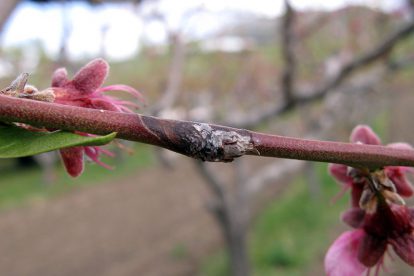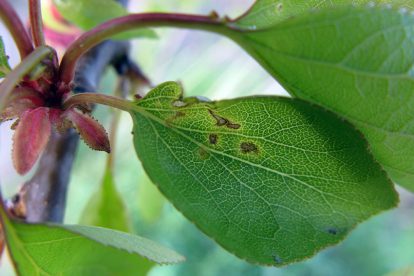In this Issue:
- Apple, Pear: fire blight, codling moth for southern Utah ONLY (dates for northern Utah coming later)
- Apricot, Peach/Nectarine: coryneum blight
APPLE, PEAR
Fire Blight
Risk is extreme; infections may happen on OPEN blossoms in warm, wet weather

Fire blight is a bacterial plant disease that causes infections through open flowers, so whether you take action depends on if your trees are blooming yet.
Fire blight affects apple, pear, quince, crabapple, ornamental pear, and hawthorn. Infections occur during warm, wet days.
It is a disease that needs moisture to cause infection, which can come from dew, or a short rainfall. Where fire blight has been a problem in past years, it is better to be safe and protect the blossoms of young trees especially.
There is an EXTREME risk of infection for all areas of Utah through May 6. Rain is in the forecast for some northern Utah locations for this Thursday. Where appropriate (open blossoms and rain), apply a treatment May 3.
The infection risk drops to “CAUTION” and “LOW” in northern Utah on May 7 and 8.
You can watch fire blight predictions on Utah TRAPs by selecting a location closest to you, and then selecting “fire blight” under the Pest drop-down menu.
Treatment
- For commercial producers, most areas (except the southern part of Utah County, which has resistance) can use streptomycin on May 3 (if open flowers). Where resistance occurs, producers should use oxytetracycline (MycoShield) and/or Kasumin. One application can be a mix of oxytetracycline and streptomycin.
- USU research found good success with using Blossom Protect as a first application, followed by an antibiotic (at full bloom), and followed by Serenade toward the end of bloom.
- Most diligent backyard growers should not need to apply an antibiotic. (Although if necessary, most garden centers carry streptomycin. Apply it on Wednesday, May 3 if flowers are open.) Instead, monitor trees closely starting two weeks after full bloom (which is when infections start to become visible). Prune out new infections immediately (on a dry day).
Codling Moth for Southern Utah ONLY

No action to take now in northern Utah; dates in southern Utah shown below
Information on spray dates for northern Utah will be delivered May 10.
To determine codling moth spray dates, we hang monitoring traps in Utah orchards. Once those traps catch moths, we can then run the calculations to determine the dates. As of now, we have not caught any moths yet in northern Utah.
For southern Utah locations, the dates to apply your first spray of the season are shown below. Options of spray materials can be found on the codling moth table on this post.
- Capitol Reef – May 21
- Castle Valley: May 18
- Enterprise: May 30
- Hurricane: May 2
- Kanab area: May 19
- Leeds: May 4
- Moab: May 16
- Springdale: May 4
- St. George: May 2
Treatment
| Product Name | Efficacy | Residual Length (days) | Comments |
|---|---|---|---|
| CONVENTIONAL | |||
| Spectracide Triazicide (gamma-cyhalothrin) | Good to Excellent | 14-17 | wait 21 days to harvest |
| Monterey Bug Buster 11 (esfenvalerate) | Good to Excellent | 14-17 | wait 21 days to harvest |
| Bonide Fruit Tree & Plant Guard (lambda-cyhalothrin) | Good to Excellent | 14-17 | wait 21 days to harvest |
| Bonide Malathion; Hi Yield Malathion | Good | 5-7 | max 2 applications; some products are pears only |
| GardenTech Sevin (zeta-cypermethrin) | Good to Excellent | 14-17 | wait 14 days to harvest |
| ORGANIC | |||
| AzaSol, EcoGarden (azadirachtin) | Good | 7-10 | purchase online |
| Cyd-X (codling moth virus) | Good (if populations are low) | 7 | works best when used at beginning of generation; expensive and purchase online |
| oil such as All Seasons Oil, EcoSmart, Neem oil | Good on eggs only | 3 | recommended for first application of the generation only |
| Ortho Fruit Spray; Fertilome Fruit Tree Spray; Safer End All; Bonide Orchard Spray (all contain pyrethrin) | Good | 3-5 | |
| Monterey / Fertilome Spinosad; Captain Jack's Deadbug Brew; Natural Guard (all contain spinosad) | Good | 10 | max 6 applications per season; if applying to peach or cherry, can re-apply after 7 days |
Peach/Nectarine, Apricot
Coryneum Blight
If coryneum blight is a problem on your peach, nectarine, or apricot trees, note that one of the most important times to apply a fungicide is the shuck split stage (see image above).
This pathogen is spread primarily by rain, and optimal conditions for infection are when temperatures are from 70 to 80°F.
Treatment
Commercial growers can find options by clicking here.
Backyard growers can use one of the following:
- Spectracide Immunox or Fertilome F-Stop (same ingredient)
- Daconil (or related; containing chlorothalonil); Note that chlorothalonil cannot be used between post-shuck split and harvest.
- Captan
- Natural Guard Copper Soap (organic, but not as effective)




